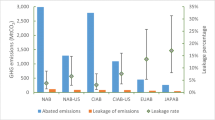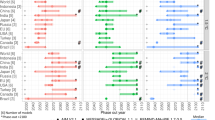Abstract
The outcome from the December 2012 climate negotiations in Doha has clarified the rules regarding surplus units for the Kyoto Protocol. We summarize these new rules and estimate the resulting effective emissions during the second commitment period using our unit trade model. Other options to deal with surplus emission allowances are employed as benchmarks to assess the Doha outcome. The effective emissions for developed countries as a group under the Doha outcome could be 10–11 % below 1990 levels or 4–5 % points below business-as-usual levels for the second commitment period if we assume that non-Kyoto Protocol countries domestically achieve their targets. However, if mechanisms exist where non-Kyoto Protocol countries can trade units, their emissions could increase and effective emissions for developed countries could be 7–8 % below 1990 levels. In this low-ambition situation we find the main impact of the Doha surplus rules to be the introduction of the historical cap on emissions allowances. Without the effect of the cap, the Doha outcome allows the Parties to the second commitment period to emit at business-as-usual levels until 2020, while still leaving surplus units at the end of the second commitment period.
Similar content being viewed by others
Notes
ERUs are not additional to AAUs or RMUs, but are converted from existing AAUs or RMUs from the host country.
Initial assigned amount is the level of assigned amount units a country is issued at the start of a commitment period, as defined in Article 3, paragraphs 7 bis, 8 and 8 bis, of the Kyoto Protocol.
The EU’s declaration only applies to the CP2 QELRC submitted in Doha. For higher ambition, they will use surplus.
NF3 is included in Annex A of the Kyoto Protocol since the Doha conference in 2012 but is not included in our calculations because of lack of data.
References
Allan A, Kruppa M (2012) Belarus negotiator hints at Kyoto exit, says others could follow. http://uk.reuters.com/article/2012/12/10/us-climate-talks-kyoto-idUKBRE8B90ZY20121210. Accessed 5 Mar 2013
BP (2012) Statistical Review of World Energy 2012. http://www.bp.com/assets/bp_internet/globalbp/globalbp_uk_english/reports_and_publications/statistical_energy_review_2011/STAGING/local_assets/spreadsheets/statistical_review_of_world_energy_full_report_2012.xlsx. Accessed 30 June 2012
Climate Action Tracker (2012) www.climateactiontracker.org. Accessed 24 Sept 2012
Depledge J (2000) Tracing the origins of the Kyoto Protocol: an article-by-article textual history. UNFCCC, FCCC/TP/2000/2
Dobrovidova O (2013) Russia threatens ‘radical measures’ in response to Kyoto Protocol extension, http://www.rtcc.org/russia-threatens-radical-measures-in-response-to-kyoto-protocol-extension/. Accessed 5 Mar 2013
den Elzen MGJ, Meinshausen M, Hof AF (2012) The impact of surplus units from the first Kyoto period on achieving the reduction pledges of the Cancun agreements. Climatic Change 114(2):401–408
Grassi G, Elzen MGJ, Hof AF, Pilli R, Federici S (2012) The role of the land use, land use change and forestry sector in achieving Annex I reduction pledges. Climatic Change 115(3–4):873–881
King E (2013) Belarus, Ukraine, Kazakhstan and Russia meet to discuss kyoto, http://www.rtcc.org/belarus-ukraine-kazakhstan-and-russia-meet-to-discuss-kyoto/. Accessed 5 Mar 2013
Kollmuss A (2013) Doha Decisions on the Kyoto surplus explained, http://carbonmarketwatch.org/wp-content/uploads/2013/03/CarbonMarketWatch-CO18-Surplus_decisions_explained_4March20131.pdf. Accessed 4 Mar 2013
Nabel J, Macey K, Chen C (2010) PRIMAP reference data for LULUCF accounting, https://sites.google.com/a/primap.org/www/the-primap-model/documentation/reflulucf. Accessed 24 Sept 2012
Nabel JEMS, Rogelj J, Chen CM, Markmann K, Gutzmann DJH, Meinshausen M (2011) Decision support for international climate policy—the PRIMAP emission module. Environ Model Softw 26(12):1419–1433
Point Carbon (2012) Carry over of AAUs from CP1 to CP2 - future implications for the climate regime. See http://carbonmarketwatch.org/wp-content/uploads/2012/11/AAU-banking-briefing-paper-Point-Carbon.pdf. Accessed 7 Mar 2013
PRIMAP (2012) PRIMAPBaseline Reference: PRIMAP4BIS. http://sites.google.com/a/primap.org/www/the-primap-model/documentation/baselines/primap4bis. Accessed 15 Feb 2013
Rogelj J, Chen C, Nabel J, Macey K, Hare W, Schaeffer M, Markmann K, Hohne N, Andersen KK, Meinshausen M (2010) Analysis of the Copenhagen accord pledges and its global climatic impacts-a snapshot of dissonant ambitions. Environ Res Lett 5(3):034013
UNEP (2011) Bridging the emissions gap: a UNEP synthesis report. United Nations Environment Programme (UNEP)
UNEP (2012) The emissions gap report. United Nations Environment Programme (UNEP), Nairobi
UNEP Risø(2012) CDM/JI pipeline analysis and database. See http://www.cdmpipeline.org/publications/JiPipeline.xlsx. Accessed 2 Aug 2012
UNFCCC (1997) Article 13 Paragraph 13, Kyoto Protocol to the United Nations Framework Convention on Climate Change, FCCC/CP/1997/7/Add.1. http://unfccc.int/resource/docs/convkp/kpeng.pdf. Accessed 15 Oct 2012
UNFCCC (2005) Decision 13/CMP.1, Modalities for the accounting of assigned amounts under Article 7, paragraph 4, of the Kyoto Protocol, Annex, paragraphs 15 and 16, FCCC/KP/CMP/2005/8/Add.2. http://unfccc.int/resource/docs/2005/cmp1/eng/08a02.pdf. Accessed 15 Oct 2012
UNFCCC (2011) Compilation of economy-wide emission reduction targets to be implemented by parties included in Annex I to the Convention, FCCC/KP/AWG/2011/INF.1/Rev.1. http://unfccc.int/resource/docs/2011/sb/eng/inf01r01.pdf. Accessed 15 Oct 2012
UNFCCC (2012a) Analysis of quantitative implications of options for addressing the surplus and carry-over of Kyoto units for the second and subsequent commitment periods of the Kyoto Protocol. http://unfccc.int/files/meetings/ad_hoc_working_groups/kp/application/pdf/awgkp_carryover_050912.pdf. Accessed 15 Oct 2012
UNFCCC (2012b) AOSIS revised proposal on surplus, May 18, 2012. http://unfccc.int/files/meetings/ad_hoc_working_groups/kp/application/pdf/awgkp_aosis_infsubmission_3.pdf. Accessed 15 Sept 2012
UNFCCC (2012c) Brazil proposal on carry-over: submission on surplus and carry-over of AAUs. http://unfccc.int/files/meetings/ad_hoc_working_groups/kp/application/pdf/awgkp_brazil_infsubmission_2.pdf. Accessed 15 Sept 2012
UNFCCC (2012d) Outcome of the work of the Ad Hoc Working Group on Further Commitments for Annex I Parties under the Kyoto Protocol., FCCC/KP/CMP/2012/L.9. http://unfccc.int/resource/docs/2012/cmp8/eng/l09.pdf. Accessed 28 Feb 2013
UNFCCC (2012e) Proposal by the G77 & China on carry-over. http://unfccc.int/files/meetings/ad_hoc_working_groups/kp/application/pdf/awgkp_g77c_surplus_040912.pdf. Accessed 15 Sept 2012
UNFCCC (2012f) Proposed Africa Group carry-over amendment for KP CP2, Bonn 2012. http://unfccc.int/files/meetings/ad_hoc_working_groups/kp/application/pdf/awgkp_africangroup_infsubmission.pdf. Accessed 15 Sept 2012
Vieweg M, Schaeffer M, Chen C, Gütschow J, Hare B, Mace M, Rocha M, Macey K (2012) Political implications of the long-term effect of surpluses from the first and second Kyoto period, Climate Analytics working paper 2. See www.climateanalytics.org. Accessed 24 Feb 2013
Yamin F, Depledge J (2004) The international climate change regime, a guide to rules, institutions and procedures. Cambridge University Press, Cambridge
Acknowledgements
We acknowledge and appreciate funding by the Federal Ministry for the Environment, Nature Conservation and Nuclear Safety (11_II_093_Global_A_SIDS_and_LDCs), and by the European Climate Foundation for the Climate Action Tracker.
Author information
Authors and Affiliations
Corresponding author
Rights and permissions
About this article
Cite this article
Chen, C.M., Gütschow, J., Vieweg, M. et al. Impact of the Doha outcome on surplus emission allowances and their effect on developed country emissions. Climatic Change 120, 845–857 (2013). https://doi.org/10.1007/s10584-013-0841-1
Received:
Accepted:
Published:
Issue Date:
DOI: https://doi.org/10.1007/s10584-013-0841-1




